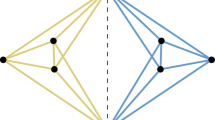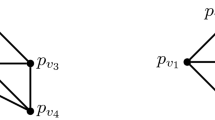Abstract
By definition, a rigid graph in \(\mathbb {R}^d\) (or on a sphere) has a finite number of embeddings up to rigid motions for a given set of edge length constraints. These embeddings are related to the real solutions of an algebraic system. Naturally, the complex solutions of such systems extend the notion of rigidity to \(\mathbb {C}^d\). A major open problem has been to obtain tight upper bounds on the number of embeddings in \(\mathbb {C}^d\), for a given number |V| of vertices, which obviously also bound their number in \(\mathbb {R}^d\). Moreover, in most known cases, the maximal numbers of embeddings in \(\mathbb {C}^d\) and \(\mathbb {R}^d\) coincide. For decades, only the trivial bound of \(O(2^{d|V|})\) was known on the number of embeddings. Recently, matrix permanent bounds have led to a small improvement for \(d\ge 5\). This work improves upon the existing upper bounds for the number of embeddings in \(\mathbb {R}^d\) and \(S^d\), by exploiting outdegree-constrained orientations on a graphical construction, where the proof iteratively eliminates vertices or vertex paths. For the most important cases of \(d=2\) and \(d=3\), the new bounds are \(O(3.7764^{|V|})\) and \(O(6.8399^{|V|})\), respectively. In general, we improve the exponent basis in the asymptotic behavior with respect to the number of vertices of the recent bound mentioned above by the factor of \(\sqrt{2}\). Besides being the first substantial improvement upon a long-standing upper bound, our method is essentially the first general approach relying on combinatorial arguments rather than algebraic root counts.








Similar content being viewed by others
Data Availability
Data sharing not applicable to this article as no datasets were generated or analysed during the current study.
Notes
References
Asimow, L., Roth, B.: The rigidity of graphs. Trans. Am. Math. Soc. 245, 279–289 (1978)
Baglivo, J.A., Graver, J.E.: Incidence and Symmetry in Design and Architecture. Cambridge Urban and Architectural Studies, vol. 7. Cambridge University Press, Cambridge (1983)
Bartzos, E., Emiris, I.Z., Legerský, J., Tsigaridas, E.: On the maximal number of real embeddings of minimally rigid graphs in \({\mathbb{R}}^2\), \({\mathbb{R}}^3\) and \(S^2\). J. Symbolic Comput. 102, 189–208 (2021)
Bartzos, E., Emiris, I.Z., Schicho, J.: On the multihomogeneous Bézout bound on the number of embeddings of minimally rigid graphs. Appl. Algebra Eng. Commun. Comput. 31(5–6), 325–357 (2020)
Bartzos, E., Emiris, I.Z., Tzamos, Ch.: The m-Bézout bound and distance geometry. In: Computer Algebra in Scientific Computing—23rd Intern. Workshop (Sochi 2021). Lecture Notes in Computer Science, vol. 12865, pp. 6–20. Springer, Cham (2021)
Berg, A.R., Jordán, T.: Algorithms for graph rigidity and scene analysis. In: 11th Annual European Symposium on Algorithms (Budapest 2003). Lecture Notes in Computer Science, vol. 2832, pp. 78–89. Springer, Berlin (2003)
Bernstein, D.N.: The number of roots of a system of equations. Funct. Anal. Appl. 9(3), 183–185 (1975)
Billinge, S.J.L., Duxbury, P.M., Gonçalves, D.S., Lavor, C., Mucherino, A.: Assigned and unassigned distance geometry: applications to biological molecules and nanostructures. 4OR 14(4), 337–376 (2016)
Blumenthal, L.M.: Theory and Applications of Distance Geometry. Chelsea, New York (1970)
Borcea, C., Streinu, I.: The number of embeddings of minimally rigid graphs. Discrete Comput. Geom. 31(2), 287–303 (2004)
Bregman, L.M.: Some properties of nonnegative matrices and their permanents. Dokl. Akad. Nauk SSSR 211(1), 27–30 (1973). (in Russian)
Capco, J., Gallet, M., Grasegger, G., Koutschan, Ch., Lubbes, N., Schicho, J.: The number of realizations of a Laman graph. SIAM J. Appl. Algebra Geom. 2(1), 94–125 (2018)
Emiris, I.Z., Tsigaridas, E.P., Varvitsiotis, A.: Mixed volume and distance geometry techniques for counting Euclidean embeddings of rigid graphs. In: Distance Geometry, pp. 23–45. Springer, New York (2013)
Emmerich, D.G.: Structures Tendues et Autotendantes. Editions de La Villette, Paris (1988)
Felsner, S., Zickfeld, F.: On the number of planar orientations with prescribed degrees. Electron. J. Combin. 15(1), # 77 (2008)
Gallet, M., Grasegger, G., Schicho, J.: Counting realizations of Laman graphs on the sphere. Electron. J. Combin. 27(2), # 2.5 (2020)
Gáspár, M.E., Csermely, P.: Rigidity and flexibility of biological networks. Brief. Funct. Genom. 11(6), 443–456 (2012)
Grasegger, G., Koutschan, Ch., Tsigaridas, E.: Lower bounds on the number of realizations of rigid graphs. Exp. Math. 29(2), 125–136 (2020)
Harary, F.: Graph Theory. Addison-Wesley, London (1969)
Harris, J., Tu, L.W.: On symmetric and skew-symmetric determinantal varieties. Topology 23(1), 71–84 (1984)
Jackson, B., Owen, J.C.: Equivalent realisations of a rigid graph. Discrete Appl. Math. 256, 42–58 (2019)
Jungnickel, D.: Graphs, Networks and Algorithms. Algorithms and Computation in Mathematics, vol. 5. Springer, Berlin (2005)
Khovanskii, A.G.: Newton polyhedra and the genus of complete intersections. Funct. Anal. Appl. 12(1), 38–46 (1978)
Kouchnirenko, A.G.: Polyèdres de Newton et nombres de Milnor. Invent. Math. 32(1), 1–31 (1976)
Krick, L., Broucke, M.E., Francis, B.A.: Stabilisation of infinitesimally rigid formations of multi-robot networks. Int. J. Control 82(3), 423–439 (2009)
Laman, G.: On graphs and rigidity of plane skeletal structures. J. Eng. Math. 4(4), 331–340 (1970)
Maxwell, J.C.: On the calculation of the equilibrium and stiffness of frames. Philos. Mag. 27(182), 294–299 (1864)
Minc, H.: Upper bounds for permanents of \((0,1)\)-matrices. Bull. Am. Math. Soc. 69, 789–791 (1963)
Pollaczek-Geiringer, H.: Über die Gliederung ebener Fachwerke. Zeitschrift für Angewandte Mathematik und Mechanik 7(1), 58–72 (1927)
Pollaczek-Geiringer, H.: Zur Gliederungstheorie räumlicher Fachwerke. Zeitschrift für Angewandte Mathematik und Mechanik 12(6), 369–376 (1932)
Schulze, B., Whiteley, W.: Rigidity and scene analysis. In: Handbook of Discrete and Computational Geometry. CRC Press Ser. Discrete Math. Appl., pp. 1593–1632. CRC Press, Boca Raton (1997)
Shafarevich, I.R.: Basic Algebraic Geometry 1. Varieties in Projective Space. Springer, Heidelberg (2013)
Shai, O., Sljoka, A., Whiteley, W.: Directed graphs, decompositions, and spatial linkages. Discrete Appl. Math. 161(18), 3028–3047 (2013)
Steffens, R., Theobald, T.: Mixed volume techniques for embeddings of Laman graphs. Comput. Geom. 43(2), 84–93 (2010)
Streinu, I., Theran, L.: Sparse hypergraphs and pebble game algorithms. Eur. J. Combin. 30(8), 1944–1964 (2009)
Tay, T.-S., Whiteley, W.: Generating isostatic frameworks. Struct. Topol. 11, 21–69 (1985)
Whiteley, W.: Cones, infinity and \(1\)-story buildings. Struct. Topol. 8, 53–70 (1983)
Zelazo, D., Franchi, A., Allgöwer, F., Bülthoff, H.H., Giordano, P.R.: Rigidity maintenance control for multi-robot systems. In: Robotics: Science and Systems VIII (Sydney 2012), # 60. MIT Press, Cambridge (2013)
Zhu, Z., So, A.M.-C., Ye, Y.: Universal rigidity and edge sparsification for sensor network localization. SIAM J. Optim. 20(6), 3059–3081 (2010)
Acknowledgements
EB was fully supported and IZE was partially supported by project ARCADES which has received funding from the European Union’s Horizon 2020 research and innovation programme under the Marie Skłodowska-Curie Grant Agreement No 675789. EB and IZE are members of team AROMATH, joint between INRIA Sophia-Antipolis, France, and NKUA.
Author information
Authors and Affiliations
Corresponding author
Ethics declarations
Conflict of interest
The authors declare that they have no conflict of interest.
Additional information
Editor in Charge: Kenneth Clarkson
Publisher's Note
Springer Nature remains neutral with regard to jurisdictional claims in published maps and institutional affiliations.
Rights and permissions
About this article
Cite this article
Bartzos, E., Emiris, I.Z. & Vidunas, R. New Upper Bounds for the Number of Embeddings of Minimally Rigid Graphs. Discrete Comput Geom 68, 796–816 (2022). https://doi.org/10.1007/s00454-022-00370-3
Received:
Revised:
Accepted:
Published:
Issue Date:
DOI: https://doi.org/10.1007/s00454-022-00370-3




